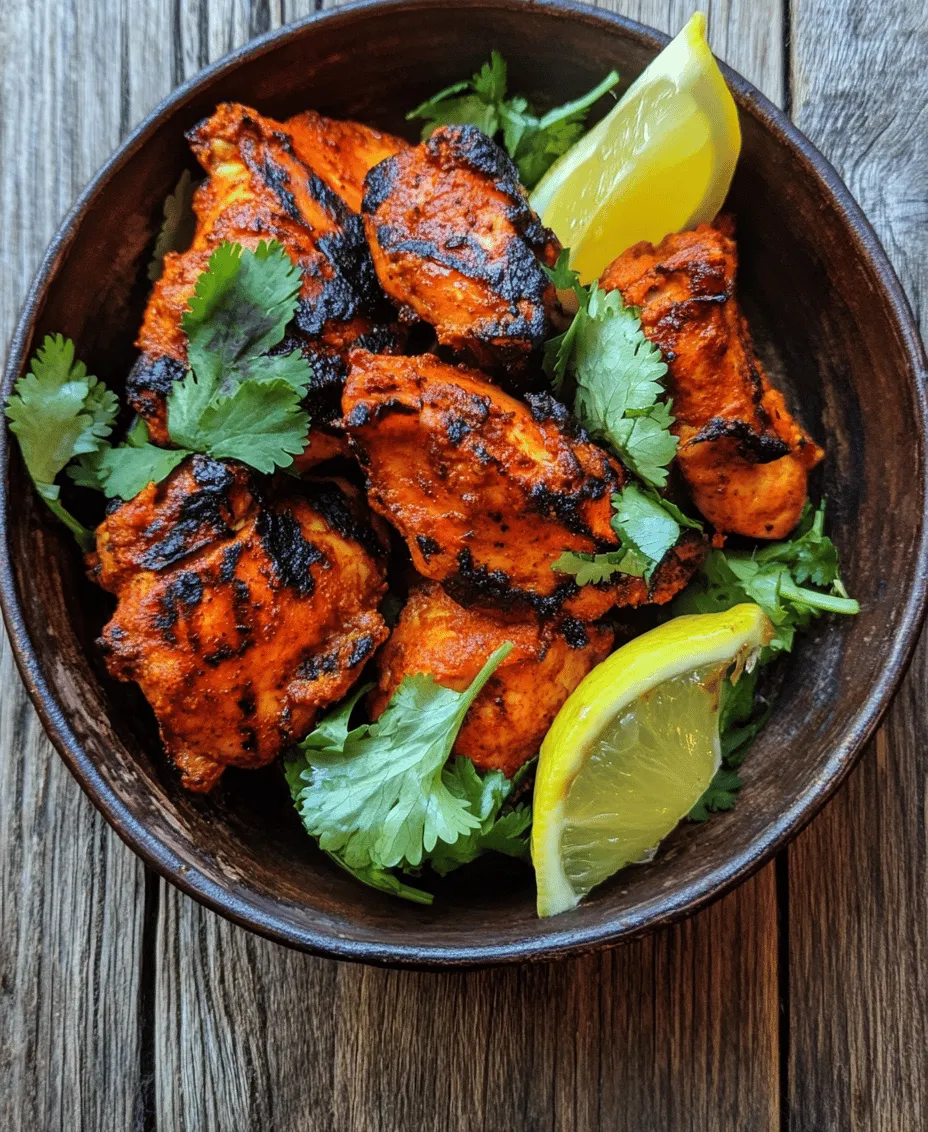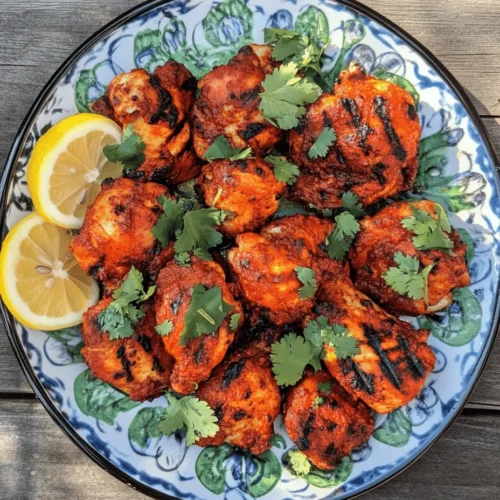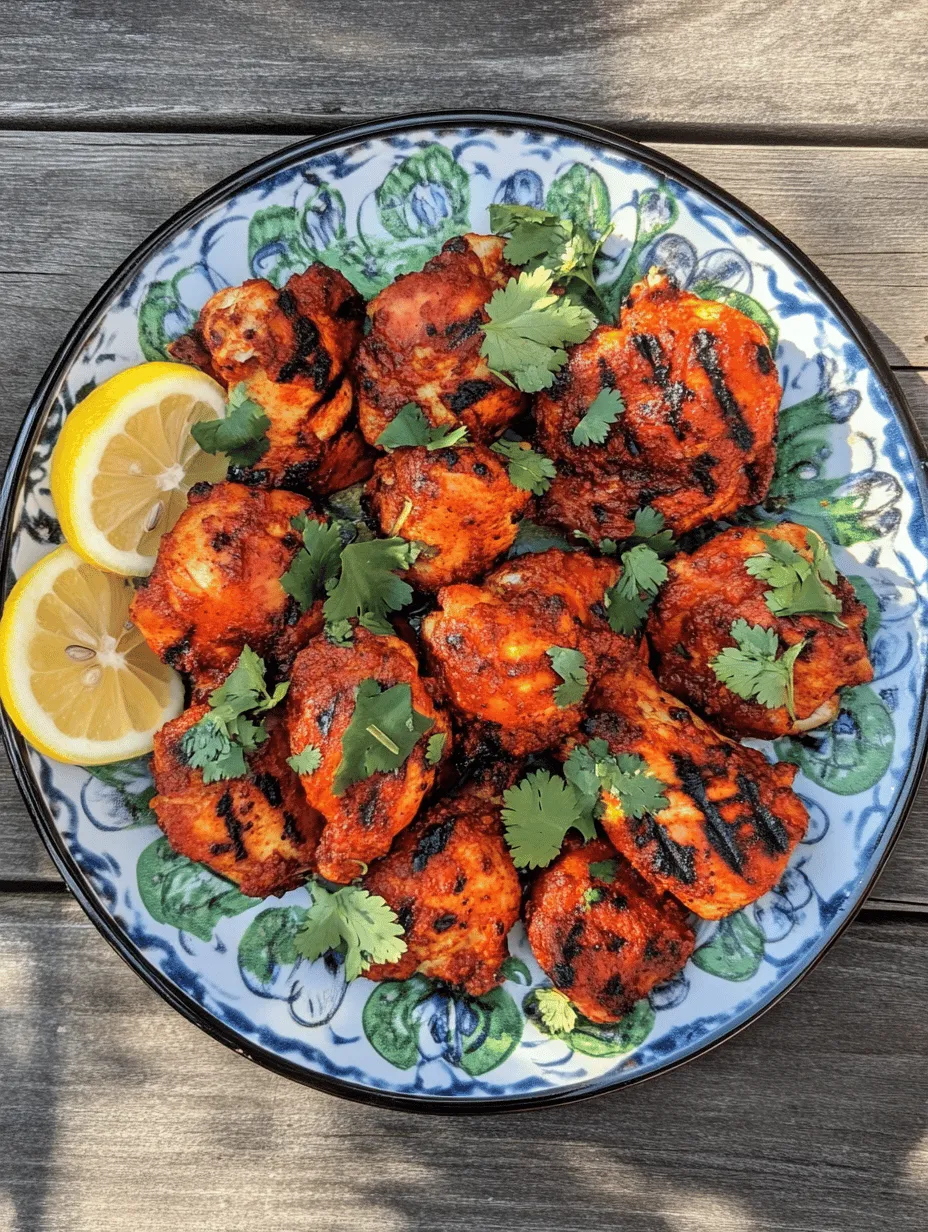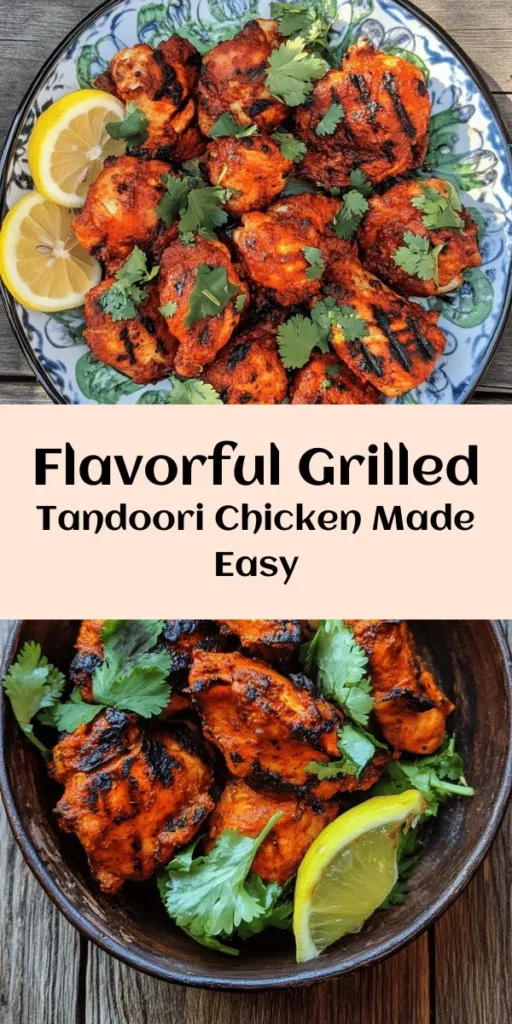Introduction
Grilled chicken has carved a special niche in culinary traditions across the globe, celebrated for its versatility, richness, and the myriad of flavors it can encapsulate. Whether marinated in zesty citrus or savory herbs, grilled chicken remains a beloved dish that brings together friends and family around the grill. Among the many variations of grilled chicken, Tandoori chicken stands out with its vibrant hues, tantalizing aroma, and complex flavor profile that captures the essence of Indian cuisine.
Originating from the Indian subcontinent, Tandoori chicken has become a staple in many households and restaurants worldwide. The dish is characterized by its bright red color, which comes from a blend of spices, and its smoky flavor, which is achieved through cooking in a traditional clay oven known as a tandoor. The marination process is crucial, allowing the spices to penetrate the meat, resulting in tender and flavorful chicken that is grilled to perfection. In this article, you will discover how easy it is to replicate this restaurant-quality dish right in your own kitchen, using simple ingredients and techniques.
Understanding Tandoori Chicken
Historical Background of Tandoori Cooking
Tandoori cooking has roots that stretch back thousands of years, with origins believed to be in the Indian Punjab region. The traditional method involves cooking meats in a tandoor, a cylindrical clay oven that reaches extremely high temperatures, imparting a unique smoky flavor. Originally, this technique was used for various meats and breads, with the tandoor’s heat sealing in moisture while giving the food a distinct char. The advent of tandoori cooking was not just about flavor; it also represented a communal way of eating, where families and friends would gather around the tandoor, sharing food and stories.
The modern adaptation of Tandoori chicken is a delightful evolution of this historical cooking method. In contemporary kitchens, we often opt for grilling or baking, making it accessible for home cooks without the need for specialized equipment. The essence of Tandoori chicken remains intact, delivering the same robust flavors and textures that have delighted palates for generations.
Explanation of Tandoori Masala
At the heart of Tandoori chicken lies the Tandoori masala, a spice blend that gives the dish its signature flavor and color. Tandoori masala typically includes a medley of spices such as coriander, cumin, paprika, cayenne, turmeric, and garam masala, each contributing its unique characteristics. The combination results in a warm, aromatic blend that beautifully complements the chicken.
The significance of Tandoori masala extends beyond flavor; it also plays a role in health benefits. Many spices used in the blend have anti-inflammatory and antioxidant properties, making Tandoori chicken not only a delicious option but a healthier one as well.
Health Benefits of Using Greek Yogurt
A key component in the Tandoori chicken marinade is Greek yogurt, which serves multiple purposes. Not only does it help tenderize the chicken, but it also acts as a flavor carrier, allowing the spices to cling to the meat. The lactic acid in yogurt breaks down the protein fibers in chicken, resulting in a succulent texture that is incredibly satisfying.
In addition to its tenderizing properties, Greek yogurt is a nutritional powerhouse. It is rich in protein, probiotics, and calcium, making it a healthier alternative to many other marinade bases. The addition of yogurt not only enhances the flavor profile of the chicken but also contributes to its overall healthfulness, making grilled Tandoori chicken a guilt-free indulgence.
Ingredients Breakdown
To create the perfect Grilled Tandoori Chicken, it’s essential to understand the role each ingredient plays in the dish. Here’s a closer look at the key components that come together to create this flavorful meal:
Chicken Thighs
When it comes to grilled chicken, chicken thighs are often preferred over breasts for a few reasons. First, they contain more fat, which makes them juicier and less likely to dry out during cooking. The dark meat of the thighs also has a richer flavor that pairs exceptionally well with the bold spices of Tandoori masala. Whether you’re grilling, baking, or roasting, chicken thighs maintain their tenderness, making them a favorite choice for Tandoori chicken.
Greek Yogurt
As mentioned earlier, Greek yogurt is a fundamental ingredient in the Tandoori marinade. Its creamy texture allows the spices to adhere better to the chicken, while its tanginess adds depth to the flavor. Additionally, Greek yogurt’s ability to marinate meats without overpowering them makes it an ideal base for this dish. It provides the necessary acidity to tenderize the chicken and infuse it with flavor.
Vegetable Oil
While the marinade primarily consists of yogurt and spices, vegetable oil plays a critical role in the cooking process. It helps to prevent sticking on the grill and assists in achieving that coveted charred exterior. Additionally, oil helps to lock in moisture, further enhancing the juiciness of the chicken. Using a neutral oil, such as canola or grapeseed oil, is recommended to keep the focus on the Tandoori flavors.
Fresh Herbs and Spices
The flavor of Tandoori chicken is greatly enhanced by the inclusion of fresh herbs and spices. Here are some essential components:
– Garlic: This aromatic adds depth and richness, balancing the spices in the marinade.
– Ginger: Fresh ginger contributes a zesty kick and is known for its digestive health benefits.
– Tandoori Masala: The star of the show, this spice blend is what defines the dish. It can be purchased pre-made or easily made at home.
– Cumin: This warm spice adds a nutty flavor, enhancing the overall taste of the marinade.
– Paprika: For both color and a mild peppery flavor, paprika is essential in achieving the vibrant red hue of Tandoori chicken.
– Turmeric: Known for its anti-inflammatory properties, turmeric adds an earthy flavor and a golden color.
– Salt: Essential for enhancing the overall flavor, salt draws moisture out of the chicken and helps the marinade penetrate more effectively.
Homemade Tandoori Masala vs. Store-Bought Options
While store-bought Tandoori masala is convenient, making your own at home allows for personalization and freshness. A simple blend of the spices mentioned above can be adjusted to suit your taste preferences. For those who enjoy cooking and experimenting with flavors, creating homemade Tandoori masala can elevate your dish even further.
Importance of Garnishes
Garnishes might seem like an afterthought, but they play a crucial role in the presentation and flavor of your Tandoori chicken. Fresh cilantro adds a burst of color and a refreshing taste that complements the spices. Lemon wedges not only enhance the visual appeal but also provide a zesty brightness that can cut through the richness of the chicken. A squeeze of lemon just before serving can elevate the dish, adding a refreshing contrast to the smoky, spicy flavors.
Marination Process
The marination process is where the magic truly happens for grilled Tandoori chicken. The right combination of ingredients, along with sufficient marinating time, will ensure that your chicken is bursting with flavor and tenderness.
1. Prepare the Marinade: In a large mixing bowl, combine Greek yogurt, minced garlic, grated ginger, Tandoori masala, cumin, paprika, turmeric, and a generous pinch of salt. Whisk until smooth and evenly mixed.
2. Marinate the Chicken: Add the chicken thighs to the marinade, ensuring each piece is thoroughly coated. For best results, use your hands to massage the marinade into the chicken, allowing the spices to penetrate the meat.
3. Chill: Cover the bowl with plastic wrap and refrigerate for at least 2 hours, although overnight is ideal. This extended marination time allows the flavors to meld and the chicken to tenderize effectively.
4. Prepare for Grilling: When ready to grill, remove the chicken from the refrigerator and let it sit at room temperature for about 30 minutes. This step ensures even cooking and helps achieve a nice sear on the grill.
5. Preheat the Grill: Preheat your grill to medium-high heat, ensuring it’s well-oiled to prevent sticking.
The marination process is essential for creating a dish that is not only flavorful but also tender and juicy. The right marinade transforms ordinary chicken into a culinary delight, making grilled Tandoori chicken a dish worth mastering.
In the next section, we will delve into the grilling instructions and some tips for achieving the perfect grilled Tandoori chicken that will impress your family and friends alike. Stay tuned for the mouthwatering details!

Step-by-Step Guide on Preparing the Marinade
Creating the perfect marinade for your Grilled Tandoori Chicken is essential for infusing the meat with robust flavors and achieving the signature Tandoori taste. Follow these detailed steps to prepare your marinade:
1. Gather Ingredients: Start with the following ingredients for the marinade:
– 1 cup plain yogurt (preferably Greek for its thickness)
– 2 tablespoons vegetable oil (for moisture)
– 2 tablespoons lemon juice (for acidity)
– 1 tablespoon grated ginger
– 1 tablespoon minced garlic
– 2 teaspoons ground cumin
– 2 teaspoons ground coriander
– 2 teaspoons garam masala
– 1 teaspoon smoked paprika (for a smoky flavor)
– 1 teaspoon turmeric
– 1 teaspoon cayenne pepper (adjust for spice level)
– Salt to taste
2. Combine Ingredients: In a large mixing bowl, combine the yogurt, vegetable oil, lemon juice, ginger, garlic, and all the spices. Whisk everything together until you have a smooth, homogeneous mixture. The yogurt acts not only as a flavor carrier but also tenderizes the chicken.
3. Prepare the Chicken: While the marinade is being prepared, you can prepare your chicken. Make deep slits in the bone-in, skinless chicken thighs. This allows the marinade to penetrate deeper into the meat, enhancing flavor and tenderness.
4. Marinate: Place the chicken thighs in the bowl with the marinade, ensuring each piece is well-coated. For the best flavor, cover the bowl with plastic wrap and refrigerate for at least 4 hours, but overnight is ideal. The longer the chicken marinates, the more flavorful and tender it will become.
Tips for Achieving the Best Flavor
To ensure your Grilled Tandoori Chicken is bursting with flavor, consider these helpful tips:
– Marination Time: Always allow sufficient marination time; a minimum of 4 hours is required, but overnight is recommended. This extended time allows the spices to fully penetrate the chicken, creating a richer flavor profile.
– Use Bone-In, Skinless Thighs: For the best results, use bone-in, skinless chicken thighs. The bone helps retain moisture during grilling, and the skinless option allows the marinade to cling to the meat better, resulting in a more flavorful dish.
Grilling Techniques
Mastering the grilling technique is crucial for achieving that perfectly charred and juicy Tandoori chicken. Here’s how to approach the grilling process:
1. Overview of the Grilling Process: Preheat your grill to a high temperature, ideally between 400°F to 450°F. This high heat will create a nice sear on the outside while cooking the chicken evenly on the inside.
2. Charcoal vs. Gas Grilling:
– Charcoal Grilling: Provides a smoky flavor that complements the Tandoori spices well. If using charcoal, allow the coals to reach a grayish-white color before placing the chicken on the grill.
– Gas Grilling: Offers more control over temperature and is generally easier to manage. Preheat the grill for about 10-15 minutes on high before reducing the heat to medium.
3. Achieving Perfect Grill Marks: To achieve those beautiful grill marks, place the chicken thighs skin-side down (if applicable) on the grill and avoid moving them for the first 5-7 minutes. This will allow them to form a nice crust. After that, turn them 90 degrees to create crosshatch marks.
4. Cooking Evenly: Ensure the chicken is cooked evenly by rotating the pieces every few minutes. Use a digital meat thermometer to check for doneness; the internal temperature should reach 165°F.
5. Resting the Chicken: After grilling, allow the chicken to rest for 5-10 minutes. This resting period is essential as it allows juices to redistribute throughout the meat, ensuring each bite is juicy and flavorful.
Serving Suggestions
Once your Grilled Tandoori Chicken is ready, it’s time to elevate your dining experience with the right accompaniments:
– Complementary Side Dishes:
– Basmati Rice: Fluffy basmati rice is a classic pairing. You can serve it plain or with saffron for added flavor.
– Naan: Soft, warm naan bread is perfect for scooping up the chicken and any accompanying sauces.
– Salad: A refreshing salad with cucumbers, tomatoes, and a tangy dressing can balance the spices of the Tandoori chicken.
– Creative Serving Ideas:
– Wraps: Shred the grilled chicken and serve it in wraps with fresh veggies and a drizzle of yogurt sauce for a quick meal.
– Bowls: Create a Tandoori chicken bowl by serving the chicken over rice with roasted vegetables and a sprinkle of fresh herbs.
– Traditional Accompaniments: Serve alongside mint chutney or raita (a yogurt-based side) for a cooling contrast to the spicy chicken.
Nutritional Information
Understanding the nutritional benefits of your Grilled Tandoori Chicken can help you enjoy it as part of a balanced diet:
– Protein-Rich: Chicken is an excellent source of lean protein, which is essential for muscle repair and overall health.
– Healthy Fats: The inclusion of yogurt and a small amount of oil adds healthy fats that are beneficial for heart health.
– Vitamins and Minerals: The spices used in Tandoori chicken, such as turmeric and coriander, offer antioxidant properties and various vitamins and minerals.
In terms of macronutrient balance, a serving of grilled Tandoori chicken provides a good amount of protein, moderate fats, and minimal carbohydrates, making it suitable for low-carb diets. However, as with any dish, portion control is important. Pairing it with healthy sides ensures a well-rounded meal.
Conclusion
Grilled Tandoori Chicken is not only a delightful dish but also a simple one to prepare, making it perfect for both weeknight dinners and entertaining guests. Its rich flavors and aromatic spices create a memorable meal that is sure to impress.
Feel free to experiment with the recipe by adding your unique touches, such as marinating with different spices or incorporating additional ingredients like vegetables. The joy of grilling lies in its versatility and the ability to share delicious meals with friends and family. So fire up that grill, and enjoy the tantalizing flavors of homemade Grilled Tandoori Chicken.



